Ron Ludekens
Identifying Unknown Peach
This peach is aproxamately the size of a softball at ripen, it is a white meat and not nearly as sweet as the golden meated peaches. It also is a freestone and has an abundance of juice to each fruit.
I am sugar sensitive and cannot eat the regular "golden meats" in any quantity. These wonderful peaches were so much less sweet that I could enjoy a whole peach right from the tree. I do so miss this fruit and would greatly appreciate any information I could get re guarding it.
Thank you for your time and efforts, sincerely, Lisa - Boley, OK
P.S. The regular Large Elberta peach in your listing greatly resembles my peach.
Answer:
Lisa, I am puzzled by your question and observations. As a rule of thumb, white flesh peaches are very sweet, soft and watery (abundance of juice) and for the most part less flavorful that yellow peaches. On the opposite end, yellow fleshed peaches generally have more flavor and are more firm. Some yellow peaches are very 'acidic' and have a strong flavor but not as much sweetness. These are the kind my father likes to eat. Other peaches tend to be more on the sweet side, less sub-acid and sometimes softer and juicier. My preferences lean to the sweeter choices. Thus I am confused by your sugar sensitivity and aversion to yellow peaches when it is the white fleshed peaches that should cause a bigger problem.
To my knowledge all the Elberta and similarly Elberta-named peaches are yellow fleshed - not white. But they do have great flavor and enough sweetness to make my taste buds very happy.
We used to grow the Hal-berta Giant Peach which was a very large peach with pink blush yellow skin, sweet yellow flesh, freestone and ripened in August. It might be similar to the one you are describing.
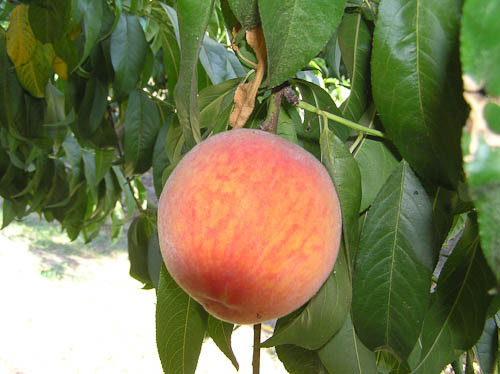
These were mostly sold in the northern half of Texas. We discontinued growing it a number of years ago since sales we so small - a shame since I think it was one of the better peaches.
One you might like to try is the Loring Peach which will do in your colder area, has a nice blend of sweet and flavor and even has a nice spring bloom.
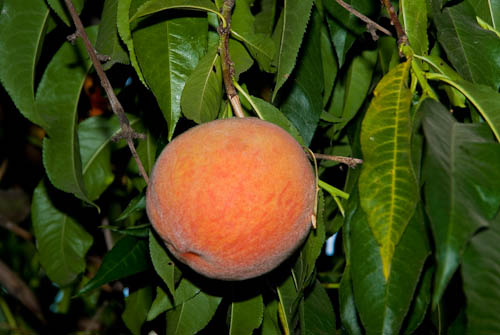
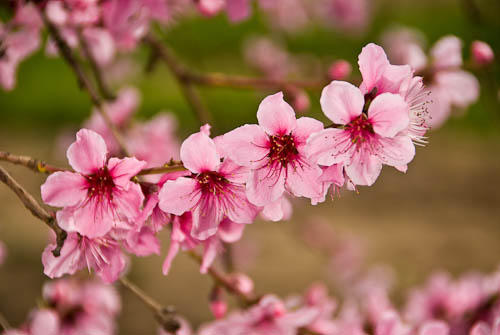
I am sure you can find some Loring Peaches in one of the Independent Retail nurseries near you or at least in Oklahoma City.
I hope this has been of some help.
Ron
Kiowa Blackberries - On Steroids?
When my father, Bob Ludekens, was on his sales trip to Oklahoma in June, he saw blackberries larger than he had ever seen before.
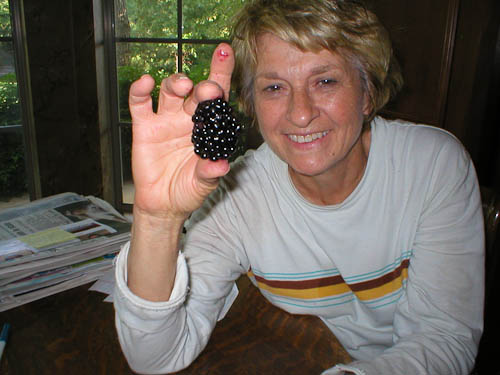
Jean Snow showing Kiowa Blackberry from 2010 crop.
He had stopped by our long time customer Sorghum Mill Tree and Blackberry Farm in Edmond, Oklahoma. Owner John Knight had shown him these humongous Kiowa Blackberries.
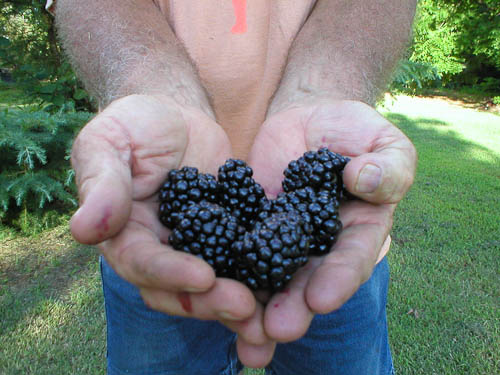
John was kind enough to take these photos last week and send them to us. He commented that these were near the end of season and not as large as the ones Bob was looking at earlier. Clearly, John knows how to grow blackberries! John also said that maybe these photos might be useful to sell more berry plants. I certainly think so - kinda why I'm writing this blog. Thank you John for the photos and permission to use them.
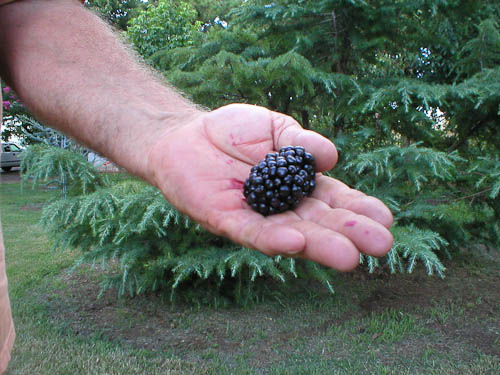
Sales manager Tom Fetch made the comment - "Wow! Blackberries on Steroids" - hence the blog title.
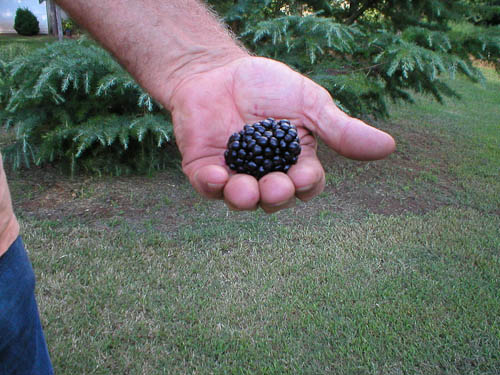
Now I'm getting hungry. Blackberry pie anyone? With Ice Cream? On your morning cereal? With yogurt? Yumm. Off to the pie shop I go....
Enjoy.
Ron Ludekens
Thumbs Up
Today we culminated a week of sales training with a walk through the fields and budwood orchards.
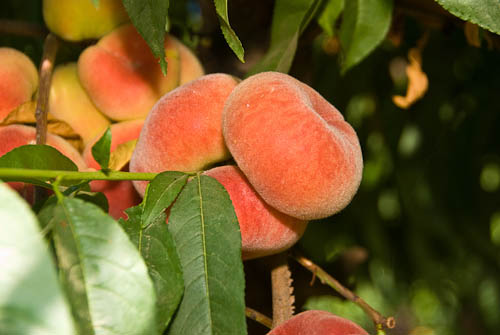
As we passed the ripe Donut (Saturn) Peaches and were refreshing ourselves with their sweet, sugery goodness, I recalled a conversation I had with a customer earlier this year in Texas. As I was describing the improvement of size and flavor of the Galaxy Peach over the Donut Peach, he commented, "can you pop the seed out of the Saturn Peach like I do with the Donut Peach?"
"Huh?"
"Yeah, I use my thumb and pop the seed right out of the peach and it looks like a donut - hole and all. Now you can eat the whole thing."
Since I had never tried this or heard of such a thing, I plead ignorance.
Today, we got to try it. Or at least Kevin did while we watched. (As the newest member of our sales staff, he gets volunteered for a lot of things.)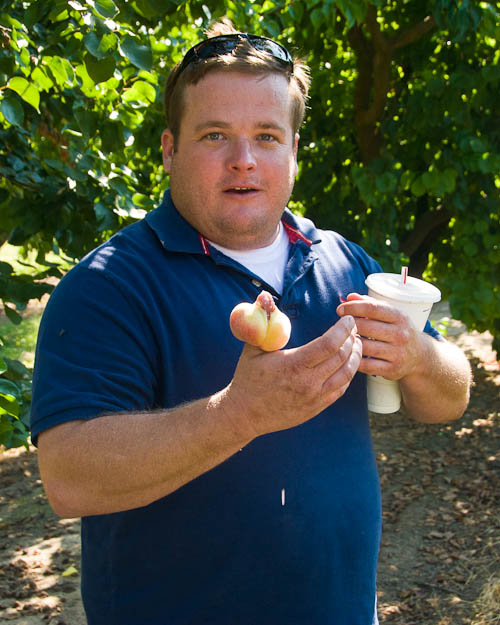
Guess what, it works! 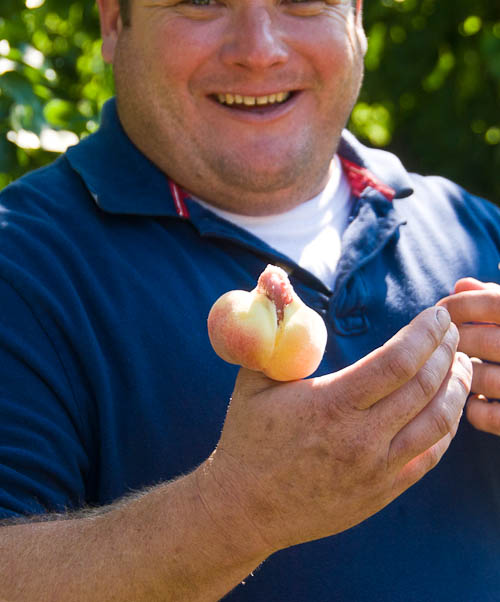
Seed is gone. Now what?
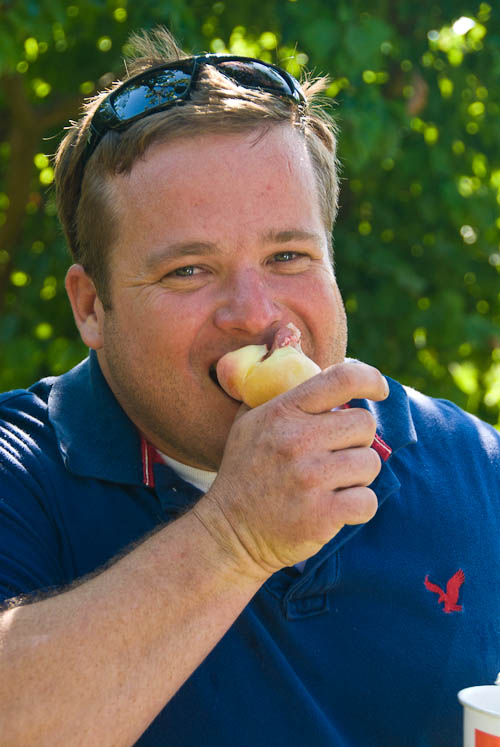
Seems a new way to eat Donut Peaches has been discovered.
What about the Galaxy Peach?
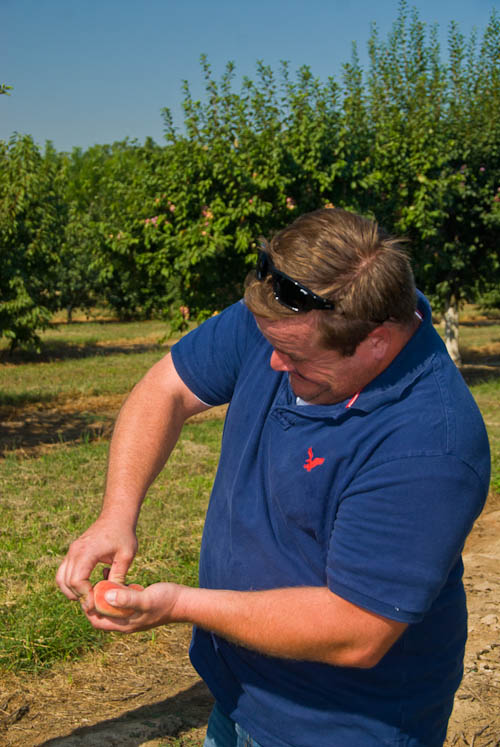
Here is Galaxy Peach. Larger for sure. But about a week or so before it is fully ripe. Peach pits do not pop well out of hard, unripened peaches - so we decided to save Kevin's thumb for another week. To be continued....
Ron Ludekens
No One Leaves Blue
Front Page News - Very Delicious
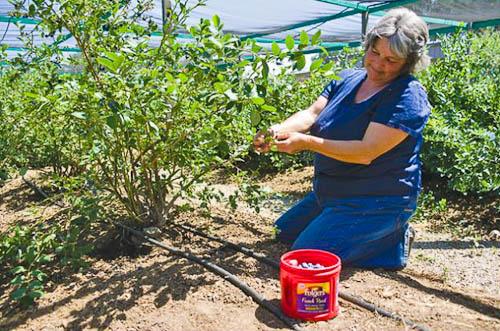
Denise Fugate, owner of Primarily Perennials by Denise, picks blueberries. Porterville Recorder Photo by Reneh Agha
We were pleased to see one of our customers featured in a front page article of the Porterville Recorder. Read Article here.
Well done and likely to drive many customers to their location. Congratulations Denise!
Title, article and photos © by Porterville Recorder
Lilac Posters - Pre-Selling Idea
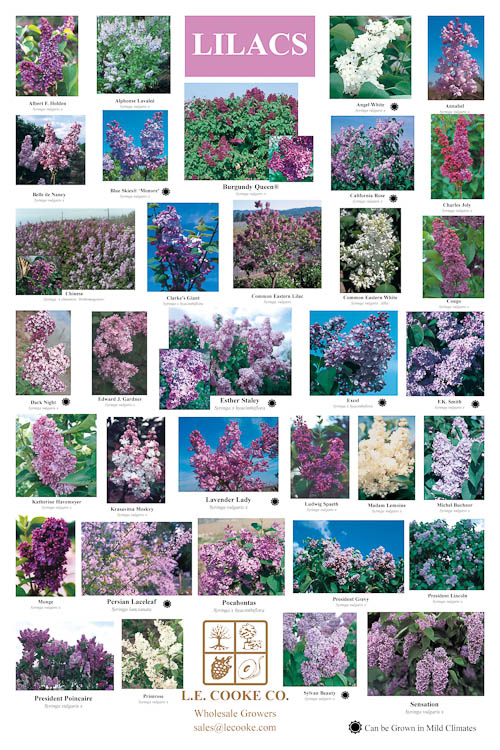
In recent years I have had mixed feeling about our Lilac Poster.
This poster was the first (and so far only) poster we have made and I had high expectations for it back in the days before we even had a website. It was originally received well and continues to be received well for the ones we still give out. After all, photos are always in demand and help sell products.
But it is not used much by our customers and I understand why. You put the poster up and invariably your customer wants the one(s) you don't carry or have in stock. As much as I'd like for you to carry all 34 varieties on the poster, that is not practical.
The reality is, the poster is a good resource for the nursery staff but a little too broad to promote sales within your nursery. Kind of like our sales hallway covered in J.F. Schmidt's posters with lots of trees that won't grow in our climate. A good resource for internal use.
AN IDEA HOW TO USE THE LILAC POSTER
Kevin returned from a sales trip last week and shared what happened at a nursery that has triggered an idea.
After he made his sales pitch for the nursery to consider adding lilacs to their inventory, the nursery manager held up the poster and asked some of her customers (she knew them by name!) which ones they would like to buy. Three customers, three selections and a commitment to get them next spring.
Wow, maybe the poster should be used as a pre-sell poster! As you book orders from the poster, add them to your bareroot order for your January (through March) deliveries. In other words, show the poster before your season instead of during the season. The poster is $7.00 if we mail it to you (cost is postage and tube) or ask your salesperson if they have any in their vehicle and it's free.
If you don't want to show the whole poster, just add the 8.5 x 11 point of sale pages to your pre-sell binder for your customers to select from.
Pre-selling your stock and taking a deposit is good business. More about that concept in a future post.
Ron L.
L.E. Cooke In The News
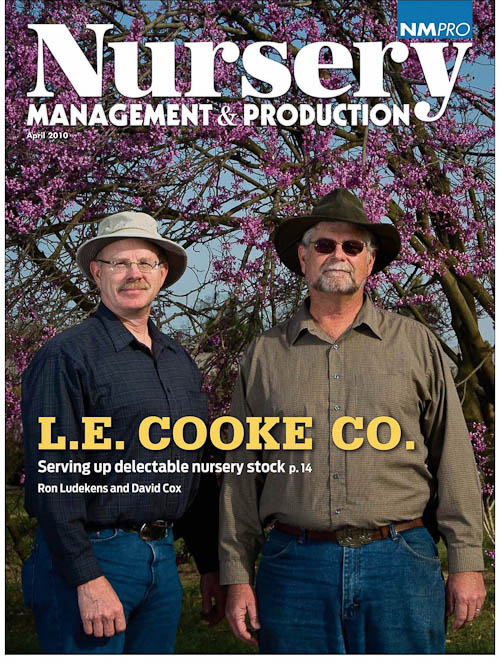
I really appreciated Nursery Management Production magazine and Kelli Rodda for the cover exposure and nicely written story in the April 2010 issue of NM-Pro magazine. The article was concisely written and conveyed accurately the "flavor" (pun intended) of what we are about. Of course they might have hurt their magazine circulation with these rough looking guys on the cover.
Here is the article: NM-Pro Article
By the way, that is a Mexican Redbud we are standing in front of.
Ron Ludekens
Cherries in Dallas Area
Question: Hello..
I am interested in growing cherry trees in my orchard in the Dallas area. My favorites are the Rainier cherry & the Bing cherry. I am interested in puchasing them from you, but I was wondering if you know how well they will grow in my area.
Please let me know. Lance
Answer: I wish I could give you a confident "go ahead" but I cannot. Over the years I have had wholesale growers in your climate have nothing but troubles with cherries.
Here are some of the issues for growing sweet cherries:
1) You need plenty of chill hours (900-1,000) and you have that easily. One check in your favor.
2) Cherry rootstock is water sensitive and needs well drained soil. I know that soils in your general area can vary greatly but a lot of what I have seen would not meet this requirement. If you happen to be in a sandy loam or old riverbed area, you might get by.
3) Cherry fruit will crack and become unsellable if it rains near harvest - probably June in your region. This is often a problem and can totally ruin a crop.
4) High humidity adds to all sorts of molds and fungus and other fuzzy undesirables on cherries and also affects the foliage and health of the tree. I believe the heat and high humidity has been the biggest cause of cherry tree losses in your climate.
Texas A&M does not recommend cherries and I suspect it was from others' negative experience. If you want to try, order a few locally or from mail order and try them on a very small scale first.
Ron L.
Fruit on Flowering Plums
Question: Can I eat the fruit from a Prunus C. KRAUTER VESUVIUS TREE? Lena - Las Vegas
Short Answer: To my knowledge it won't hurt you - but I do not think you would like it. So I would not eat it and toss it out.
Long Discussion: Let me expand on the topic of fruit on purple leaf flowering plums.
For the most part, we (you buyers and us growers) do not like to have fruit that is not worth eating on an ornamental tree. It becomes a nuisance but we tolerate it since we like the other attributes of the tree (stunning spring bloom, purple foliage spring through fall, etc.).
Krauter Vesuvius Flowering Plum is extremely popular and the number one seller of purple leaf plums for several reasons. It has a great, showy spring bloom of light pink blossoms and holds a very good purplish-black foliage from spring through fall without reverting to bronze-green in the late summer months. Where this tree became very popular was in the mild winter areas where there was not a lot of winter chill. There the tree usually would not produce nuisance fruit. In colder winter areas (like yours in Las Vegas) or in mild winter areas where an abnormal winter cold spell hit, then the tree will fruit just like many other trees.
Thundercloud Flowering Plum is also very popular because of its showy spring bloom of light pink blossoms and its purplish-black foliage from spring through fall. This tree is considered more cold hardy that the Krauter Vesuvius and we recommend it in the colder areas. It will fruit always - regardless of winter cold intensity. Please note that there are two selections of this tree on the market under the same name. The one we grow is more cold hardy and holds its purple-black foliage color all through the hot summer months. In fact, it is very difficult to distinguish it from the Krauter Vesuvius unless you know how to look. There is another one that is grown by others that turns a bronze-green during the hot summer months and thus less desirable. It also is not as cold hardy. I think it is a mistake to grow that selection of the tree.
Purple Pony® Flowering Plum is a special variety introduced by L.E. Cooke. It is a smaller growing tree (naturally dwarf) reaching only 12-15 feet with strong purple foliage that also holds its strong color from spring through fall. We have observed it since 1962 and we have never seen it set fruit nor heard of anyone experiencing fruit in climates from USDA Zones 5 through 10. This has become a very popular tree for yards where smaller size is important and near sidewalks where you do not want nuisance fruit. I feel its main weakness is it is not as showy in the spring with the pale pink blooms - a little stingy in my opinion.
So in Las Vegas, both Krauter Vesuvius and Thundercloud are equally great (nearly identical) choices and both will fruit. Purple Pony will be smaller with lighter spring bloom and the season long purple foliage and no nuisance fruit.
Ron L.
Pomegranates in North Texas
Question: 1) Does Pomegranate grow well in Dallas, Texas?
2) I would like to grow the "big" fruit of Pomegranate, which type of Pomegranate do you recommend? I saw on your web site and there are several of them?
3) Which nurseries are your vendors?
Thank you very much for your time.
Tho - Dallas Texas
Answer:Not really, in my opinion. I do not recommend them for your area. There are several issues of concern - any of which could cause disappointment.
First is winter cold. Most pomegranates, when fully dormant will survive your normal winter cold. Notice I said "fully dormant" and "normal" winter cold. I have seen the most damage to a pomegranate when spring is starting, the pomegranate softens, buds swell or even start to leaf and then a frost comes in to do the damage. In our climate, this is rare, but in your climate, it happens much more often. It is for this reason I do not recommend our great Angel Red® Pomegranate since I have seen it have more problems with late frosts than others. Most dormant pomegranates can withstand winter cold to around 10 degrees F. On given years, you can get colder and for longer than normal (like last winter). Those years may cause plant loss.
Second is length of season. Most pomegranates ripen in October in hot desert like conditions where spring starts in late February and March and really begins to get cold in October or late September. Your season is much shorter. I noticed that Texas A&M's Agricultural Extension Service in Tarrant County recommends pomegranates as an ornamental shrub (with occasional fruit)(Recommended Plants for North Texas) but does not have a fruiting pomegranate on their recommended fruit tree list (Tarrant County Fruits, Nuts and Berries). Is this because of a season too short for the fruit? I do not live in Dallas so do not have personal experience here.
Third is fungal diseases brought on by humid weather. The further east, the wetter and larger the problem. And pomegranates will split apart if it gets rain late in the season as the fruit is maturing. You can still make juice from it but doesn't look very attractive.
Fourth is well drained soils. Pomegranates are desert loving, drought tolerant plants. They absolutely will not like being planted in overly wet, poorly drained soils.
So, I do not recommend pomegranates in your area. If you are willing to plant a pomegranate with the understanding that your climate has issues that can disappoint you, you might try Wonderful (large and best known), Austin (Syrian pomegranate which has worked well in Austin, TX and places further northwest), Grenada (month earlier for shorter season but smaller than Wonderful) and Utah Sweet (pale pink from Southern Utah area - being slightly more cold tolerant).
I do not have any nurseries immediately in your areas carrying the pomegranates because of the reasons above. Closest by car would be Temple, Georgetown, Austin or areas further south or mail order.
Good luck.
Ron L.
Beautiful Central Texas
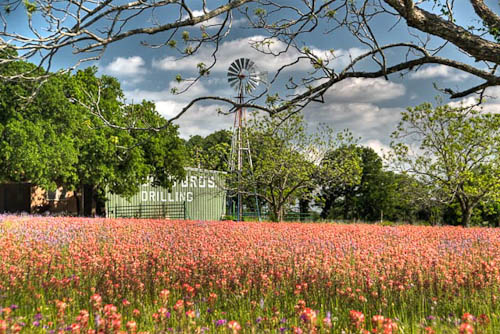
I just returned yesterday from a marvelous two week sales trip into central Texas (roughly covering from San Antonio to Fort Worth). Now, to be honest, I have only been to Texas in August - always tied in with the annual TNLA trade show. My impressions had always been, let's politely say, uncomfortable. Hot and humid.
Well, my impressions have changed mightily. What a pretty state!!! Lush green, rampant wildflowers and comfortable weather - although I did have to hold on to my hat a lot. Locals tell me the drought from last year and the abundant rain this year has made for one of the best wildflower seasons in decades. I took the photo above on the drive from Seguin to Adkins of my very first day.
I was running fast to see all the customers I could so did not have a lot of time to set up the camera and tripod except on a few evenings. More photos to come (especially of the Hill Country) when I get some of the piles of work off my desk.
Another beautiful thing about Texas are the people. I have always enjoyed the people of Texas. Even as a child attending the trade shows, I could remember how friendly everyone was (yes, we have been going to the show over 50 years). Now, as I imposed on precious time during the busy spring season, I was still warmly greeted in friendship. Thank you to each of you for your hospitality. Come visit us so we can return the favor.
Ron L.

